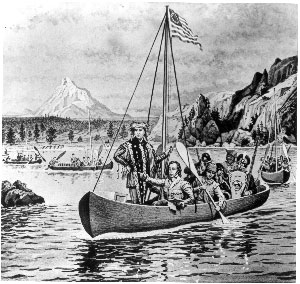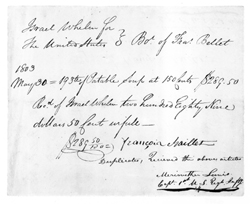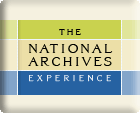April 2004 Feature
Meriwether Lewis Goes Shopping
 |
| Lewis and Clark and their party carried almost two tons of supplies—enough
to see them through a 28-month journey across 7,500 miles. (306-PSD-58-17825) |
In President Thomas Jefferson's America there were no shopping malls. So in the spring of 1803, the President sent Meriwether Lewis to the nation's commercial hub—Philadelphia—to gear up for the trek Lewis would lead across the North American continent.
In a shopping spree that lasted several weeks, Lewis assembled an astonishing array of materials: gunpowder, flints, and lead; soap, overalls, stockings, shirts, tablespoons, and blankets; mosquito curtains, scales, whiskey, sealing wax, salt, and more. A file of receipts and lists at the National Archives documents Lewis's purchases—evidence of the wise and meticulous planning that contributed to the success of the legendary voyage that is known today as the Lewis and Clark Expedition.
Working with President Jefferson and the young nation's foremost experts in astronomy, medicine, botany, anatomy, and math, Lewis drew up lists of provisions the party would need to fulfill its unique mission: to explore and report on the geography, geology, astronomy, zoology, botany, and climate of the West; to seek new trade routes; and to befriend the western tribes of the Indians.
Armed with the shopping lists and with a thousand-dollar draft from the War Department, he and Israel Whelan, the "Purveyor of Public Supplies," made their rounds of Philadelphia business establishments to accumulate the necessary goods.
They bought camping equipment—107 yards of brown linen to make into tents, oiling for all the linen sheeting, and hooks and eyes; and they bought tools—two handsaws, one screw auger, one handvise, and a bench. They purchased 25 felling axes and 24 files, as well as nails, chisels, and cord.
With regard to clothing, the nation's foremost physician, Dr. Benjamin Rush, advised that flannel be worn next to the skin, especially in wet weather. So from Matilda Chapman they purchased 45 flannel shirts with linen collars and wristbands.
For food, they would hunt, fish, and depend on the trade and generosity of the Indians. They bought fishing equipment—large hooks, drum lines, rock lines, and reels—from George R. Lawton's tackle shop. Some food they would take with them. From cook François Baillet they purchased 193 pounds of portable soup (dried paste made from beef, eggs, and vegetables), a concoction so unpopular that it would be consumed only when the party was close to starvation.

This receipt documents Lewis's purchase of 193 pounds of "portable
soup." [larger
image]
To help fulfill the diplomatic aspect of the expedition, the party would carry presents and trade goods: 500 brooches and 72 rings from a Philadelphia silversmith shop and 130 rolls of pigtail tobacco. A list of "Indian Presents" also includes knives, blankets, corn mills, tomahawks, and combs.
In keeping with early 19th-century medical science and the best advice of Dr. Rush, Lewis filled the party's first-aid kit with medicines related to bleeding or purging the patient. Other medicines would combat venereal disease. The apothecary of George Gillaspy and Joseph Strong provided calomel, tartar emetic, mercury, glauber's salt, syringes, lancets, and tourniquets. Amazingly, only one person in the party, Sgt. Charles Floyd, would die during the journey, from an ailment that medical historians now believe was caused by a ruptured appendix.
The single most expensive item Lewis purchased in Philadelphia was a mathematical instrument—a $250 gold chronometer used to calculate longitude. A Hadley's Quadrant, a mariner's compass, pole chains, thermometers, microscopes, and scales were among the other instruments the party would carry.
And to make up the portable packs that would hold all this gear, Lewis obtained rawhide for pack string and 30 sheepskins ("taken off the animal as perfectly whole as possible . . . or otherwise about the same quantity of oil cloth bags").

This list shows what Lewis determined would be necessary to make up
packs to hold the party's gear. [larger
image]
On May 14, 1804, a year after that unique shopping foray, the permanent party of 33 hale and hearty souls left its winter quarters at Camp Wood, just upstream from St. Louis, and ventured into Louisiana Territory, newly transferred from France to the United States. With all their gear packed and loaded, the men launched their 55-foot keelboat and two smaller boats into the mouth of the Missouri River. The explorers were carrying nearly two tons of supplies and equipment—all they would need to see them through 28 months and more than 7,500 miles of hardscrabble adventure and exploration.
Several items critical to the success of the mission appear on a list of "Mathematical Instruments": six papers of ink powder, four metal pens, one set of small slates and pencils, two crayons, and writing paper. With these items, Lewis and Clark filled 20 volumes describing what they found and what they did throughout the two and a half years of their journey. These journals offered Americans their first breathtaking glimpse of the vast territory that lay west of the Mississippi River.
Stacey Bredhoff
Senior Curator, Museum Programs
PDF files require the free Adobe Reader.
More information on Adobe Acrobat PDF files is available on our Accessibility page.
